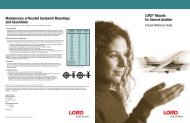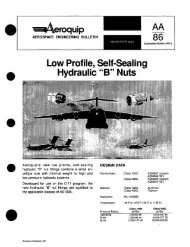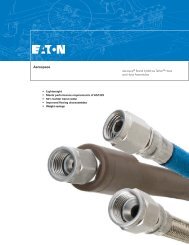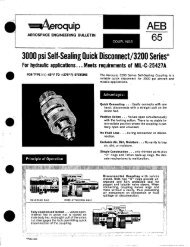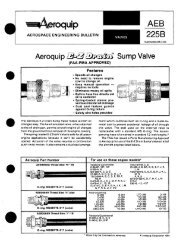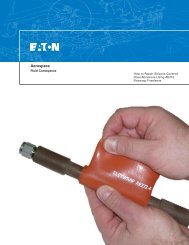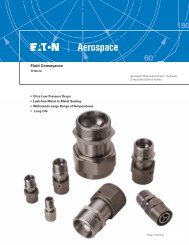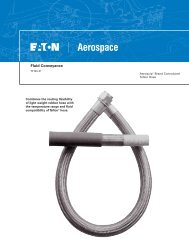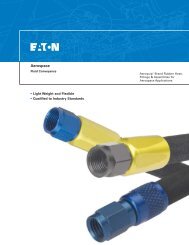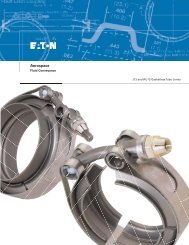Centurion Seal - Herber Aircraft
Centurion Seal - Herber Aircraft
Centurion Seal - Herber Aircraft
Create successful ePaper yourself
Turn your PDF publications into a flip-book with our unique Google optimized e-Paper software.
1200 Series Circumferential Segmented <strong>Seal</strong>s<br />
<strong>Centurion</strong> Brand 1200 Series<br />
Circumferential Segmented<br />
<strong>Seal</strong>s<br />
In addition to face type seals<br />
as previously described, many<br />
aircraft and industrial gas<br />
turbines apply circumferential<br />
segmented seals in severe<br />
environment applications<br />
requiring high reliability and<br />
long life in. Segmented carbon<br />
seals are also used as barrier<br />
seals in industrial compressors.<br />
Such seals are ideal in<br />
applications where long axial<br />
movements are anticipated<br />
due to thermal or mechanical<br />
phenomena usually found in<br />
today’s rotor-machinery systems.<br />
Typical sizes range from<br />
shaft diameters of 1.6” (4 mm)<br />
to 10.0” (250 mm).<br />
Circumferential segmented<br />
seals are comprised of a<br />
series of segmented carbon<br />
rings, which are configured<br />
to contact the shaft or runner<br />
(rotor). These segments are<br />
contained within a seal housing,<br />
then locked into position<br />
with anti-rotation keys or pins.<br />
A secondary seal is formed by<br />
the axial spring loading of the<br />
seal rings against the finely<br />
machined intermal surface of<br />
the housing. A garter spring<br />
contains the segments together<br />
and applies the circumferential<br />
load at the dynamic<br />
sealing interface. A unique<br />
joint configuration at each end<br />
of the segments results in a<br />
minimal leakage at each joint.<br />
The segments are pressure relieved<br />
to control actual contact<br />
loads, both axially and radially,<br />
and are configured so that<br />
during transient movement,<br />
a continuous sealing dam is<br />
always in contact with either<br />
the primary or secondary sealing<br />
surfaces.<br />
other liquid. In the presence<br />
of a liquid, seal ring segments<br />
are subject to lift open due<br />
to viscous effects, unless a<br />
special design is applied which<br />
would allow the seal ring segments<br />
to close the seal at its<br />
interface using such features<br />
as hydrodynamic geometry.<br />
As most circumferential-segmented<br />
seals are contacting<br />
seals, the frictional heat generated<br />
by the runner and carbon<br />
at high sliding speeds must<br />
be dissipated by an appropriate<br />
cooling method. The usual<br />
methods involve directing a<br />
flow of oil at, on or under the<br />
runner.<br />
The most common application<br />
for Eaton’s <strong>Centurion</strong><br />
brand 1200 Series seals are<br />
as mainshaft seals for stateof-the-art<br />
aircraft gas turbine<br />
engines, but other applications<br />
include compressor barrier<br />
seals (which act as a backup<br />
to high pressure, non-contacting<br />
gas seals) used in modern<br />
compressors, and in blowers,<br />
mixers and separators. <strong>Aircraft</strong><br />
seals occasionally require<br />
such design enhancements as<br />
housing windbacks, a screwlike<br />
visco seal which restricts<br />
oil at the primary sealing<br />
interface; windage screens,<br />
which attempt to keep oil<br />
to the outside and air to the<br />
inside of the sealing system;<br />
and choppers, which fling oil<br />
to the outside surfaces away<br />
from the sealing interface.<br />
1200 Series <strong>Seal</strong> Performance<br />
CENTURION BRAND<br />
1200 SERIES<br />
SEGMENTED SEAL<br />
Size (English)<br />
Size (Metric)<br />
Speed (English)<br />
Speed (Metric)<br />
Pressure (English)<br />
Pressure (Metric)<br />
Temperature (English)<br />
Temperature (Metric)<br />
Leakage (English)<br />
Leakage (Metric)<br />
Life<br />
Comments<br />
CONTACTING<br />
CIRCUMFERENTIAL<br />
SEGMENTED SEAL<br />
1.6” to 10.0”<br />
40 to 250 mm<br />
400 feet / second<br />
120 m/s<br />
90 PSID<br />
6 bar<br />
-65 to 950°F<br />
-50 to 500°C<br />
Consult with Eaton<br />
Engineering<br />
Consult with Eaton<br />
Engineering<br />
>8000 hours*<br />
ARCH-BOUND<br />
CIRCUMFERENTIAL<br />
SEGMENTED SEAL<br />
0.375” to 12.0”<br />
40 to 125 mm<br />
800 feet /<br />
second<br />
240 m/s<br />
90 PSID<br />
6 bar<br />
-65 to 900°F<br />
-50 to 500°C<br />
Consult with Eaton<br />
Engineering<br />
Consult with Eaton<br />
Engineering<br />
>8000 hours*<br />
Hydrodynamic technology can be incorporated into<br />
welded metal bellows face seals. By incorporating<br />
hydrodynamics a step change in life and performance<br />
can be realized. Hydrodynamic seals (which are noncontacting)<br />
ride on film of air therefore heat generation<br />
is essentially eliminated. The result is a seal that can<br />
survive or even thrive at conditions typically well beyond<br />
those of typical contact seals.<br />
*<strong>Seal</strong> Life is a function of operating parameters. The life provided herein is for reference<br />
only. For specific applications consult with Eaton Engineering.<br />
Circumferential seals are<br />
designed for sealing gases,<br />
and are often designed in a<br />
gas buffered tandem arrangement<br />
when sealing an oil or<br />
6 EATON CORPORATION Aerospace TF100-34 January 2008



